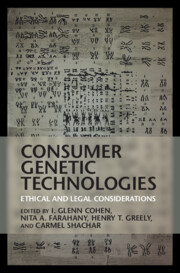Book contents
- Consumer Genetic Technologies
- Consumer Genetic Technologies
- Copyright page
- Contents
- Contributors
- Acknowledgments
- Introduction
- Part I Consumer Genetic Technologies: Rights, Liabilities, and Other Obligations
- Part II Privacy in the Age of Consumer Genetics
- Part III Tinkering with Ourselves: The Law and Ethics of DIY Genomics
- Introduction to Part III
- 10 Programming Our Genomes, Programming Ourselves
- 11 Governing Nontraditional Gene Editing
- 12 Finding a Regulatory Balance for Genetic Biohacking
- Part IV Consumer Genetics and Identity
- Part V The Impact of Genetic Information
10 - Programming Our Genomes, Programming Ourselves
The Moral and Regulatory Challenge of Regulating Do-It-Yourself Gene Editing
from Part III - Tinkering with Ourselves: The Law and Ethics of DIY Genomics
Published online by Cambridge University Press: 27 August 2021
- Consumer Genetic Technologies
- Consumer Genetic Technologies
- Copyright page
- Contents
- Contributors
- Acknowledgments
- Introduction
- Part I Consumer Genetic Technologies: Rights, Liabilities, and Other Obligations
- Part II Privacy in the Age of Consumer Genetics
- Part III Tinkering with Ourselves: The Law and Ethics of DIY Genomics
- Introduction to Part III
- 10 Programming Our Genomes, Programming Ourselves
- 11 Governing Nontraditional Gene Editing
- 12 Finding a Regulatory Balance for Genetic Biohacking
- Part IV Consumer Genetics and Identity
- Part V The Impact of Genetic Information
Summary
Genetic testing and gene editing are rapidly becoming – indeed, already are – consumer Genetic testing and gene editing are rapidly becoming – indeed, already are – consumer technologies that people can experiment with and apply on their own, potentially without any involvement by traditional payers and research funding agencies, professional scientists and healthcare providers, regulators, and medical product manufacturers. This chapter explores the challenges of regulating direct-to-consumer and do-it-yourself genomic technologies that disrupt the traditional funding, supply arrangements, and roles. It is widely understood that the U.S. Coordinated Framework for biotechnology regulation, even after a 2017 update, is a patchwork of old federal statutes that were never designed for some of the genetic technologies now emerging. This chapter explores four problems that are less well understood: First, consumer genetics poses a fundamental challenge, also seen in the sharing economy exemplified by ride-sharing platforms such as Uber and Lyft. This challenge is one of scale, and the need for regulators to oversee a massive number of small-scale transactions and individual actors. A second challenge is that consumer genetics forces a rethinking of the goals of regulation – specifically, how paternalistic is it appropriate for regulators to be? A third conundrum is whether top-down regulatory approaches can be effective and, if not, how to motivate bottom-up, citizen-led norm-setting and compliance. A final challenge concerns the fact that the human genome itself is, ultimately, software, and many of the consumer products for interpreting and manipulating it also are in the nature of software, yet traditional consumer safety regulators struggle when confronted with the task of regulating software. The chapter concludes that merely expanding the jurisdiction of existing regulatory bodies and granting them new tools and powers will not suffice. A more sweeping redesign of consumer safety regulation will be required.
- Type
- Chapter
- Information
- Consumer Genetic TechnologiesEthical and Legal Considerations, pp. 129 - 144Publisher: Cambridge University PressPrint publication year: 2021

